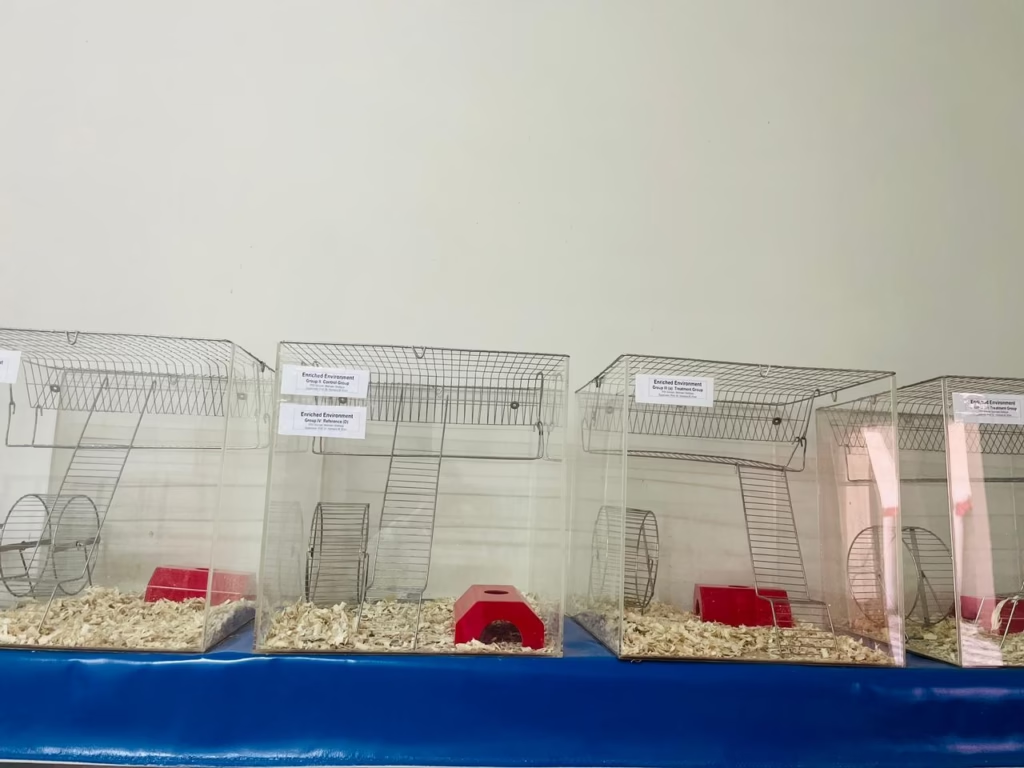Enhancing Animal Welfare Through Environmental Enrichment
Environmental enrichment plays a critical role in promoting the physical and mental well-being of animals, particularly those housed in research environments. By enhancing the sensory, social, and physical elements of an animal’s living space, we can create an environment that more closely mimics the natural conditions that these creatures experience in the wild. This not only reduces stress but can also improve the validity of scientific experiments by ensuring the animals’ welfare.
In this blog, we’ll explore the concept of Environmental Enrichment Cages, the types of experiments that can be performed within such enriched environments, and how to implement these practices effectively. We will also discuss relevant keywords and SEO strategies to optimize this article for online visibility.
What is an Environmental Enrichment Cage?
An environmental enrichment cage is a specially designed enclosure aimed at improving the living conditions of animals, particularly those used in laboratory research. These cages are designed to provide physical structures, social interactions, and sensory stimulation to mimic natural conditions as closely as possible. The idea is to give animals the opportunity to engage in species-specific behaviors, which can reduce stress and improve overall well-being.
Key Components of an Environmental Enrichment Cage:
- Physical Enrichment: Includes toys, climbing structures, tunnels, and other objects that encourage physical activity.
- Social Enrichment: Opportunities for animals to interact with others of their species.
- Sensory Enrichment: Auditory, visual, olfactory, and tactile stimuli that engage the animals’ senses.
- Cognitive Enrichment: Activities and challenges that encourage problem-solving and learning.
Why is Environmental Enrichment Important?
Environmental enrichment plays a vital role in improving the physical and psychological health of animals by providing stimulation that mimics natural conditions. Here are several reasons why it’s important:
- Prevents Boredom: Animals confined to sterile laboratory cages may develop abnormal behaviors due to boredom, which can skew experimental results.
- Enhances Natural Behaviors: Enrichment allows animals to exhibit natural behaviors like foraging, nesting, and exploring.
- Reduces Stress: By promoting positive engagement, enrichment minimizes stress, anxiety, and other negative emotions.
- Improves Scientific Accuracy: Animals in enriched environments are more likely to display behaviors and physiological responses that are more reflective of real-life scenarios.
Types of Experiments in an Enriched Environment
Enriched environments provide an ideal platform for conducting a wide variety of research experiments in fields such as neuroscience, behavior, psychology, and pharmacology. Here’s a breakdown of some experiments that can be performed in environmental enrichment cages:
1. Behavioral Research
Environmental enrichment can be used to study animal behaviors in a more naturalistic context. This is especially useful for observing how animals respond to changes in their surroundings, such as the introduction of new objects or social dynamics.
Example Experiment:
- Objective: To study the effect of environmental enrichment on the social behavior of rodents.
- Procedure: Divide the animals into two groups: one in an enriched environment with various objects and social companions, and the other in a standard, bare cage. Over a few weeks, observe and record interactions such as play, aggression, or grooming between the animals.
- Results: Enriched environments often lead to increased social behaviors, such as more grooming or cooperative interactions.
2. Cognitive and Memory Tests
Cognitive enrichment involves the use of puzzles, mazes, and problem-solving challenges that test memory, learning abilities, and decision-making skills in animals. This research is particularly important for understanding brain function and the effects of aging or disease on cognition.
Example Experiment:
- Objective: To investigate the impact of environmental enrichment on memory and spatial learning in mice.
- Procedure: Mice are placed in a maze where they have to find food rewards. One group of mice is housed in an enriched environment while the control group is in a standard cage. Test both groups by placing them in the maze and measuring how long it takes them to reach the reward.
- Results: Animals in the enriched environment may perform better in tasks requiring spatial memory and problem-solving.
3. Neurobiological Research
Environmental enrichment has been shown to affect neuroplasticity, the brain’s ability to reorganize itself by forming new neural connections. This is vital for understanding how changes in the environment can affect brain development, particularly in young animals.
Example Experiment:
- Objective: To study the effect of environmental enrichment on neurogenesis (formation of new neurons) in rats.
- Procedure: Rats are divided into two groups, with one housed in a standard cage and the other in an enriched cage for several weeks. Afterward, their brains are examined to determine the number of new neurons produced in the hippocampus (a region involved in memory).
- Results: Rats in the enriched environment may show enhanced neurogenesis, which can have implications for learning and memory.
4. Pharmacological Testing
Environmental enrichment can also be used in drug development studies. For example, researchers may examine how certain drugs impact animals living in enriched or non-enriched environments, as the presence of enrichment can alter behavioral responses and drug efficacy.
Example Experiment:
- Objective: To test the impact of an antidepressant drug in enriched vs. standard environments.
- Procedure: One group of animals is placed in a bare cage, and another in an enriched cage. Both groups receive the antidepressant drug, and behavioral changes such as anxiety or depression levels are observed through specific tests (e.g., forced swim test, open field test).
- Results: Environmental enrichment could influence how the drug performs, potentially making it more or less effective.
.

How to Set Up an Environmental Enrichment Cage
Setting up an environmental enrichment cage requires thoughtful consideration of the species and the goals of the experiment. Here are general guidelines for creating an enriching environment:
1. Physical Space and Layout:
Ensure the cage is large enough to accommodate the physical enrichment items. The more space available, the more opportunity the animal has to engage in natural behaviors.
2. Provide Varied Enrichment Items:
- Toys: Balls, ropes, or chew toys for small mammals.
- Nesting Material: Shredded paper, hay, or other materials that encourage nesting.
- Climbing Structures: For animals like primates, birds, or rodents.
- Hideaways and Tunnels: For species like rodents or reptiles that appreciate having safe hiding spots.
3. Social Interaction:
- Cohabitation: Housing animals with companions of the same species can provide social enrichment.
- Visual Stimulation: Placing animals in an area where they can observe other animals can provide additional enrichment.
4. Sensory Stimulation:
- Smell: Introduce new scents periodically (e.g., herbs or fruits) to engage the animals’ sense of smell.
- Sound: Use recorded natural sounds (like bird calls or water flowing) for auditory stimulation.
- Visual: Adding mirrors, colored objects, or videos can keep animals engaged visually.
5. Training and Challenges:
Introduce cognitive tasks such as mazes or food puzzles to stimulate problem-solving abilities. For example, using food rewards that are hidden or locked in a puzzle box can motivate animals to explore.
Conclusion
Environmental enrichment is essential for ensuring that laboratory animals are not only physically healthy but mentally stimulated and socially engaged. By providing enriched environments, researchers can reduce stress, promote natural behaviors, and enhance the accuracy and reliability of experimental results. Whether you’re a researcher or animal care specialist, understanding and implementing environmental enrichment is a powerful tool for improving animal welfare and the quality of scientific studies.

0 Comments